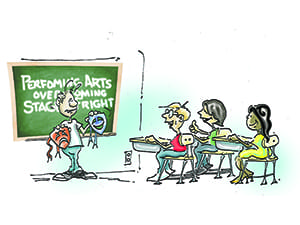In a provocative headline, a recent Wall Street Journal article proclaimed that “Rural America Is the New ‘Inner City.’” The piece profiles Kenton, Ohio, along with several other towns across the nation that have recently suffered population losses, sluggish economies, and surging substance abuse. The sudden interest in communities like Kenton is not surprising, given that President Trump rode a wave of rural and small-town support to the White House.
Long a neglected realm of school reform, rural education is also capturing more attention. Collin Roth and Will Flanders of the Wisconsin Institute for Law and Liberty point out that rural students in the Badger State post some of the lowest ACT scores and highest college remediation rates; this mirrors data from Ohio. A recent study from the Rural School and Community Trust notes that nearly half of rural students are low-income (eligible for subsidized meals) and often have limited opportunities to take Advanced Placement (AP) courses. Meanwhile, a 2014 report from the U.S. Department of Education documents the challenges rural schools face recruiting and retaining teachers and securing parental involvement.
Of course, there isn’t a single cure-all that can elevate education in sparsely populated areas. Yet interdistrict open enrollment done well tackles some of the challenges presented by rural education.
Parental choice
One issue facing families in rural areas is a lack of school options. Charters and private schools—commonly found in more densely populated areas—are rare in rural communities. In fact, Ohio’s restrictions on where charter schools can locate leads to very few setting down roots in non-urban districts. By permitting students to attend schools in another district, open enrollment is one of rural students’ few options. That’s a benefit to families seeking schools that better meets their kids’ needs—they are not limited to just their “home districts.” Our recent study on open enrollment in Ohio found that families in these areas are indeed availing themselves to this form of choice—about two thirds of open enrollees statewide reside in rural and small-town locales, amounting to roughly 40,000 pupils statewide.
Advanced or specialized offerings
As mentioned above, students in sparsely populated areas may not have the same access to rigorous coursework as their urban or suburban peers. Lack of scale is almost surely behind this problem. For instance, a small, rural high school might only have a few students who have an interest in, or are prepared for, the rigors of an AP course. As a result, their district may not offer the course because it’s cost prohibitive. In a similar vein, rural districts might have only a handful of students interested in specialized courses or extracurricular activities, such as computer programming, orchestra, school newspaper, or theater. Under open enrollment, advanced students or pupils with “niche” interests could transfer to nearby a district that does have such offerings. Of course, it may also be true that no districts in the vicinity have the offerings that a student seeks (online course choice might help in some circumstances).
Competition
Because state dollars travel with interdistrict transfers, open enrollment can help stimulate healthy competition between districts. This can energize districts to sharpen their own educational services, either to attract non-resident pupils or to retain those already living within their boundaries. As one rural Ohio superintendent commented several years ago, “Competition drives innovation.… I would like to see incoming open enrollment become more competitive, which will only further promote student achievement through parent and student motivation.” Without open enrollment—and few other choice options available—rural and small-town districts would enjoy near-unfettered monopolies over educational services in their jurisdictions. (Parents can still make residential moves or homeschool; and online charters are an option in some states as well.) While districts may find this arrangement convenient, it’s less ideal for students and families.
Transportation
One of the major challenges of rural schools is efficiently bussing students across vast but sparsely populated areas. Transporting pupils living in isolated areas creates logistical and financial burdens for students’ districts. Naturally, long commutes also burden students. Interdistrict open enrollment can help solve this dilemma in certain cases. Consider a student who resides thirty miles from her zoned school but just a few miles from a school run by a nearby district. With interdistrict open enrollment, she can actually attend her closest school. While her parents may need to drop her off at a bus stop within the neighboring district or to drive her to the school itself, those burdens may be less than traversing the long distances to her zoned school.[1] This would also alleviate the cost on the home district to transport students in remote parts of their jurisdiction.
* * *
Ohio’s rural school districts deserve high praise for participating in open enrollment, as do Buckeye legislators who, since 1989, have allowed this program to exist under state law. While our recent study doesn’t offer conclusive evidence of test-score gains for rural or small-town open enrollees (some analyses detect a small boost), the benefits discussed above suggest that open enrollment can be a valuable tool to enrich the educational experiences of non-urban children. Other states should likewise see that interdistrict open enrollment is an option in their sparsely populated communities. In the days ahead, finding ways to unlock more opportunities for children living in rural areas should be an important priority for school reform. Open enrollment is a good place to start.
[1] Ohio parents can seek from their home district a payment in lieu of transportation, which could be used to defray the costs of transporting their children to another district.



















